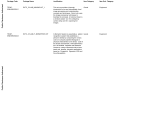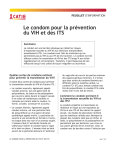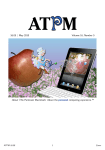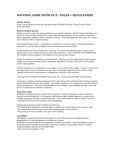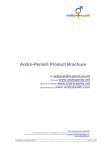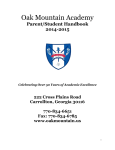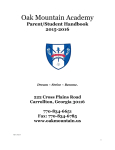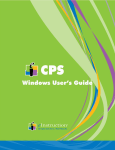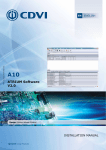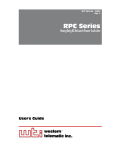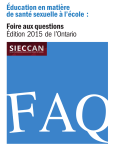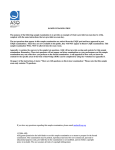Download CLASSROOM RESPONSE UNITS IN HUMAN SEXUAL BEHAVIOR
Transcript
2006-01-04-1 MAY 31, 2006 GRANDON GILL, MARILYN MYERSON, JOHNNY EL-RADY CLASSROOM RESPONSE UNITS IN HUMAN SEXUAL BEHAVIOR Dr. Marilyn Myerson, Associate Professor, Department of Women's Studies at the University of South Florida (USF), was facing a difficult decision. Over the past semester, she had been pilot testing a classroom performance system (CPS; a.k.a audience response systems) in her WST2600 (Human Sexual Behavior) undergraduate class. Initially, she had been very excited about the technology. The way it was supposed to work, every student would bring his or her personal infrared remote control (pad) to class. The instructor could then use the installed CPS system to perform a variety of tasks, such as: • • • Taking attendance Administering pop quizzes on readings or lecture material Polling the students—more or less anonymously—on their attitudes towards topics covered in the course, with results displayed on the class projection screen Unfortunately, the reality of CPS in the classroom had not lived up to its promise. The semester had been plagued by technical and user-related problems. On the technical side, the large 400 student class had overwhelmed the capacity of some of the receivers stationed around the classroom, making it nearly impossible for students to get their responses accepted. On the user side, the students had done their part to add to the general chaos surrounding the pilot test. Although required to purchase the pads, many chose not to do so. Of those who did, a substantial fraction forgot to bring the pads to class each week (forcing the GA to enter their attendance manually). Other students lost their remotes. Finally, as the semester came to a close, students began complaining that the money spent on the pads (~$12) had been wasted. Ironically, part of their complaint seemed to derive from the fact that they really liked the anonymous polling feature, when it worked… So, the question was this: should she give the system another try the next time she taught WST2600, or should she abandon the project? In this This case was prepared for the purpose of class discussion, and context, she had become aware of two other not to illustrate the effective or ineffective handling of an faculty users, one in Biology, and one in administrative or classroom situation and is copyrighted by the Informing Science Institute. Permission to make digital or paper Business. How heavily should she weigh their copy of part or all of these works for personal or classroom use is experiences in making her own decision? granted without fee provided that the copies are not made or distributed for profit or commercial advantage AND that copies 1) bear this notice in full and 2) give the full citation on the first page. It is permissible to abstract these works so long as credit is given. To copy in all other cases or to republish or to post on a server or to redistribute to lists requires specific permission and payment of a fee. Contact [email protected] to request redistribution permission. 2006-01-04-1 GILL, MYERSON & EL-RADY Classroom Performance Systems Classroom Performance Systems (CPS) was the name used by eInstruction Corporation (home page: http://www.einstruction.com) to refer to a technology also known as Audience Response Systems, as well as a variety of other names including Group Response System (GRS), Student Response System (SRS), Personal Response Systems (PRS) and Electronic Voting System (EVS). The systems, whose underlying purpose was to elicit feedback or responses from a live audience in a classroom, consisted of three required components, shown in Exhibit 1: 1. The response pads. Resembling remote controls, the lettered or numbered buttons on these pads were the source of the feedback—normally in response to a multiple choice or true/false question. Each participant had to have his or own remote. 2. The receiver. Typically mounted in the classroom (or brought in by the instructor for small classes), the receiver was normally connected to a computer, using a serial or USB port. Because individual receivers had capacity limitations (of around 90-100 students), multiple receivers might be required in a large-class situation, requiring a more complex setup. 3. The software. Provided by eInstruction as a free download, the software—which was installed on the computer connected to the receiver(s)—provided a user interface for the instructor. Among the capabilities available were: a) taking attendance, b) authoring or revising a quiz or survey, c) administering a quiz or survey to students (using the a projector connected to the PC), d) recording results and grades, e) generating various reports (e.g., attendance, grades, participation) and exporting results to a spreadsheet format. When used for higher education purposes, the eInstruction web site served as a fourth key component. Whereas K-12 versions of the system were normally self-contained, with schools purchasing pads and the receiver for a price of ~$3000 for a typical class, the higher education business model was different. In this model: • The university normally acquired the necessary receivers (for ~$300 each) • Instructors created a course on the eInstruction web site, and are supplied a class key (Exhibit 2) which the instructor will normally place in the course syllabus or on the course web site (e.g., Blackboard). • Students then acquired their own pads (a.k.a., "clickers" or "remote gizmos"). Typically, the price of the physical pad device is low ($3-$4) but students then needed to register it, using the pad's serial number, for a fee each semester (currently ~$15). • Once they registered the control for the semester, students can use the key to enroll in the course on the eInstruction web site (see Exhibit 3 for an example of instructions to students). A single registration fee covers all courses in a semester. • Once all students registered, the instructor could then download a class list into the CPS software. That list contained codes that automatically identified a particular pad as belonging to a specific student, making it suitable for taking attendance and administering quizzes. A number of variations on the basic higher education model existed. First, a number of publishers (e.g., McGraw Hill) offered a deal whereby if the faculty member adopted a qualifying textbook, the receiver and single-semester pad registrations would be provided for free. The pad registration was implemented with a single-use certificate that was bundled with the textbook—meaning that students who bought a used book had to re-register for the $15 fee. As a further incentive, those publishers also frequently included CPS question banks with the instructor's manual for the textbook. 2 Informing Faculty, 2006, Vol. 1, No. 4, pp 1-26 2006-01-04-1 CLASSROOM RESPONSE UNITS Another variation was required for much larger classes. With a range that was typically well under 100 feet—particularly if the batteries were getting low—the standard infrared units were not suitable for large auditorium classes. A second type of pad, an RF (radio frequency) pad, was normally required for those situations. The RF pads offered a number of advantages, including greater range, eliminating the need for line-of-site (the infrared must be pointed directly at a receiver, just like a television remote), rechargeable batteries and a single-receiver system that could serve up to a few thousand simultaneous students. The principal drawback of these systems was cost. Compared with the $3 infrared pad cost, the RF pad cost (~$18) represented a significant outlay to the student—doubled in the event that the pad was misplaced. From the instructor's perspective, the most critical component of the CPS system was the software. Installed on the classroom PC or the instructor's laptop, the software was used for all key activities associated with the system. As shown in Exhibit 4, areas of the software included: • • • • Class: Used to take attendance and view the class roster. Roster data could also be exported, if necessary. Lessons: Used to author lessons (i.e., quizzes, surveys) and then administer them. Each lesson consisted of a series of individual multiple choice questions with a correct answer or set of answers specified. Lessons could be imported from other CPS files, such as those used in a previous semester. Gradebook: Accumulates the results from quizzes over a specified grading period. A setting on each quiz allowed the instructor to determine whether or not to include it in the grade book, and various weighing schemes and evaluation categories (e.g., participation) could be established. Reports: Allows many different reports—from straightforward results on a single lesson (the "post" report) to complex reports relating to K-12 accountability standards—to be generated. A 200 page user's manual could be downloaded for instructors using the system. Even with the manual, however, a certain amount of trial and error tended to be required. For one thing, not all of the product features were fully described in the manual (e.g., only a fraction of the available reports were described) and the output formats generated for basic operations—such as exporting data from an entire class to a spreadsheet—could be quite involved. Another problem was the availability of training and support, which was limited. Although Myerson had been generally pleased with the response time from her publisher (McGraw Hill), she frequently found that eInstruction could not answer her GAs questions at a speed commensurate with their urgency. From the student's perspective, the system was much simpler. When a lesson was invoked from the "Lessons" area, questions generated by the instructor were displayed, one at a time. On each question, the instructor would press the "Start" button and the receiver would begin collecting data. Who had responded to a particular question was indicated by numbered squares that changed color once a button had been pressed and the answer had been received (each student knew his or her own pad number). Once a sufficient number of responses had been gathered, the instructor pressed "Stop" and, if desired, the correct response could be displayed. One particularly powerful selling point for the CPS system was its ability to chart responses on demand, using a bar chart. Thus, after responses had been collected, students could see the distribution of answers in the class. This could also be used for opinion surveys, where no correct answer was specified. It was also possible to use the system to conduct multiple choice examinations. In this mode, students were given the exam and keyed in responses by first keying in the question number, then keying in their answer. Myerson was unaware of anyone who had used the system in this mode—perhaps because it seemed to offer few advantages over the existing Scantron bubble sheets that were in use at USF while, at the same time, offering the potential of dramatically increasing the number of things that could go wrong. Informing Faculty, 2006, Volume 1, No. 4, pp 1-26 3 2006-01-04-1 GILL, MYERSON & EL-RADY WST2600: Human Sexual Behavior The class in which Myerson had pilot tested the CPS system was WST2600--"Human Sexual Behavior". The course was offered through the Women's Studies department, part of the College of Arts and Sciences at USF, a state university located in Tampa, Florida. USF was a large university—with total enrollments of nearly 50,000, its size placed it in the top 12 in the country, and the 2nd or 3rd largest in the southeast. Within USF, the College of Arts and Sciences (CAS) was the largest college, as described below (from the college web page): Our college is the largest college at USF, a Research I, Carnegie Doctoral Extensive university. CAS has 28 departments in four cognate areas: life and physical sciences, social and behavioral sciences, the humanities and professional programs. Our College's 500+ faculty and 150+ staff serve approximately 17,000 majors enrolled in 65 undergraduate majors and concentrations, 36 masters, and 14 doctoral degree programs. The Women's Studies program at USF was one of the oldest in the nation, having been established in the 1970s. In 1987, it had became the first program in Florida to offer a B.A. in Women's Studies and, by 1991, had it had achieved full departmental status within the CAS. In 1997, approval to offer a master's program in Women's Studies had been granted by the state and, at the time of the case, it was one of three such programs in the state. The department had 8 full time faculty members, many of whom had begun their career in other disciplines. Myerson, for example, who joined USF in 1973, held a doctorate in Philosophy and had been granted courtesy appointments in both the Communications and Philosophy Departments, as well as having served as an Associate Dean. The WST2600 course could be used to meet USF's general education curriculum requirements and was targeted at lower division undergraduates, primarily sophomores. Its enrollment tended to run quite high, around 400 students a semester (divided into 12 sections), and the course was very popular, with all sections routinely closing out. The content of the course, summarized in Exhibit 5 for spring 2005, was of a nature that could be very disturbing to some students. In addition to its coverage of sexual anatomy, potentially sensitive issues included gender identity, birth control and abortion, sexual abuse, sexual problems and therapy, and sexually transmitted diseases. While understanding "the facts" surrounding these issues was definitely an important aspect of the course, a particularly central course objective was getting students to understand and articulate their own viewpoints. A number of course exercises were specifically devoted to meeting this objective. First, students were required to keep weekly journals that described their personal reactions to the content presented each class. In the guidelines for preparing their weekly entries, the syllabus (Exhibit 5) stated the following: This journal is a place for you to reflect clearly (and concisely) on course materials, activities, and discussions. You will write TWO FULL pages per week on something of particular interest to you from class each week: a topic, issue, idea, guest speaker, etc. Additionally, there will be specific journal assignments announced in class. Summaries of activities will not be accepted. As a general guideline, you may wish to start with indicating your assumptions, values, beliefs, or questions about the topic; and then discuss how your thinking may have been affirmed or challenged by the class, and give reasons for your thinking. The journal entries are designed for you to write thoughtful responses and/or raise questions about ideas; these entries are to be based on your own thinking, not on any form of library or internet research, and not material copied directly from the book. 4 Informing Faculty, 2006, Vol. 1, No. 4, pp 1-26 2006-01-04-1 CLASSROOM RESPONSE UNITS The second viewpoint-related exercise was the short paper. 4-5 pages each in length. Two such papers were required each semester. Once again, these papers were not intended to be research reports. Instead, the syllabus stated: "These papers are intended to be based on your own personal experience and are NOT to be researched by copying from library or internet sources or the textbook." Combined with pop quizzes (5%) and in-class writing exercises (5%), journal (20%) and short paper assignments (15%) represented 50% of each student's grade. The remainder of the grade (50%) was determined by three non-cumulative exams. Because the course had such a large enrollment, weekly lectures were conducted off-campus, in a large auditorium at the nearby University Mall. This particular arrangement complicated the delivery of the course in a number of ways. First, it meant that students had to get to the Mall from their other on-campus classes, using their personal vehicles or university shuttles (known as "Bull Runners", in honor of USF's mascot, Rocky the Bull). This tended to produce tardiness. Second, its size was such that ensuring accurate attendance was taken could be difficult. Unfortunately, as a lower division course (many of whose students had not yet developed a mature attitude towards their studies) it was imperative that such attendance be taken. CPS Pilot Program in WST2600 Myerson first became acquainted with CPS technology through a presentation given by McGraw Hill, the publisher of the textbook used in WST2600. As she recalled, the demonstration of the technology— conducted by the book rep in a small room—had worked flawlessly. Immediately, she had become very excited about its potential uses. These included: • • • Taking attendance: As opposed to having students sign in each week (and then comparing their signatures to those used to sign in on the first class day), each student would bring a pad to lecture each Monday and the system could then be used to take attendance. This would produce a big administrative time savings. Administering pop quizzes: The system could be used to administer and grade pop quizzes that would be used to ensure that each student's mind—as well as body—had come to class. This would be a big class time savings when compared to passing out paper quizzes (to 400 students) and then grading them, either manually or using Scantron sheets. Conducting live "anonymous" in-class surveys: Using the technology, students could be polled at will regarding their opinions at any time during the course of the class and the spread of their opinions could be immediately displayed as a bar graph. While these surveys would not be truly anonymous (since each student's individual response could be accessed through the instructor's software), they would be much more private than other "real time" options, such as a show of hands1. In spring 2005, Myerson added CPS pads as a requirement to WST2600. Her initial enthusiasm for the technology then began to wane as she discovered that a limited demonstration in a small room by a trained user was an entirely unrealistic depiction of what it would be like for her (and her untrained GAs) to use the system to achieve multiple objectives in a large auditorium. Specifically, the demonstration had 1 Another faculty member, Johnny El-Rady, had proposed an ingenious way of making the survey truly anonymous: have each student exchange response pads with his or her immediate neighbor immediately before the survey was conducted. After the survey, the pads would then be restored to their rightful owners—making the instigator of each response virtually impossible to trace (without memorizing the entire class seating plan for the specific day). Informing Faculty, 2006, Volume 1, No. 4, pp 1-26 5 2006-01-04-1 GILL, MYERSON & EL-RADY left her entirely unprepared for some of the problems that she would be facing. These included both problems with the technology itself and use-related problems. The technology-related problems were principally a result of the use of infrared controls. In order for the system to work in the Mall auditorium, numerous receivers had to be set up and networked together. The USF and Mall personnel, having little or no experience with CPS systems, encountered considerable difficulties in this setup. Even when it was working, however, there was a problem in getting students to point their pads in the appropriate direction, necessary to prevent individual receivers from being overloaded. When such overloads occurred, system performance declined seriously, leading to frustration on the part of both students and the instructor. A second technology-related problem involved the software itself. While it was clear that the system was capable of collecting many types of data, the mechanisms for getting such data out were unclear. Basic attendance lists were hard enough to access; pop quiz results were even harder. Much of the time, her GA had to fall back on transferring data manually from the system. Although the procedure worked, it eliminated all of the anticipated time savings and actually added to the burden of running the class. While Myerson felt such problems could mainly be addressed through better training, it was not entirely clear where such training would come from. As she put it: We had folks come to campus for the initial set-up and that was maybe two hours—I think they were the McGraw Hill folks, not the eInstruction folks (and we did get a step by step booklet, but what we needed was the real life practice); also, at our request, there was another visit by a trainer, after semester started which grad students went to—I wasn’t able to attend; again, 1 -2 hours, and some questions answered; they also had on-line instruction but again, what we lacked was the hands-on—“it wouldn’t do this, how can I fix it now”, kind of training which would involve someone being available at an 800 number while we were in the classroom; we tried that once and didn’t get the kind of answer we needed. Overall, she felt that the McGraw Hill rep had been extremely helpful and responsive to her needs, but that rep's own training in the system had not extended beyond the basics. eInstruction, on the other hand, did not appear to be set up to answer questions at the speed necessary to keep her class running smoothly. Perhaps she and her GA were not going to the right place for help. But the company had not been particularly useful in directing her questions appropriately. An entirely different source of difficulties came from the students themselves. Among the problems encountered were: • • • • • 6 Students failed to purchase their pads at the bookstore, either failing to read the course instructions or ignoring them. Students failed to register their pads properly, either because they did not know they had to or because they did not want to pay the registration fee (which was discounted only if they purchased a new textbook). Students forgot to bring their pads to class. In these cases, regardless of what the syllabus stated, they tended to be quite adamant about getting their attendance counted. Batteries in a pad ran low, reducing its range and making it harder for the student to register his or her key presses. Students lost their pads, in which case they were annoyed regarding the need to purchase a replacement unit (although the fee to reregister the pad was usually waived by eInstruction). As a Informing Faculty, 2006, Vol. 1, No. 4, pp 1-26 2006-01-04-1 CLASSROOM RESPONSE UNITS side issue, pad replacement also meant that the class roll had to be re-downloaded from the eInstruction site. As a consequence of both the technical and user problems, Myerson's ability to use the CPS system for the course was severely impacted. Indeed, the first fully successful use of the system to take attendance did not occur until mid-April 2005, practically the end of the semester. Although the system had worked for some anonymous surveys—and the students seemed to love it when it did!—the technology had not delivered on any of its other promised benefits. This failure had negatively impacted the course in three ways. First, it had interfered with course content and organization, both of which had been designed around the assumption that the technology would be available. Second, it increased the time demands placed upon course staff. Finally, students were upset about having purchased a little-used system. In thinking about whether or not to drop the project completely, Myerson had become aware of two other faculty members who had used CPS systems with somewhat greater success. She wondered if she should, perhaps, consider their experiences in her decision-making process. Case Example 1: BSC2035 (Sex and Today's World) There are things you just cannot do in a classroom. For everything else, there’s CPS! --Johnny El-Rady The first example of successful CPS use that Myerson was aware of came from Johnny El-Rady, an Instructor in the biology department who, coincidentally, also happened to be teaching a general education course about sex. El-Rady, however, covered the course from a biological perspective— focusing on topics such as the genetic consequences of sexual reproduction—rather than on its personal or societal implications. He described himself and the course as follows: I am an instructor in the Biology Department. I teach a number of courses for majors, including General Microbiology (MCB 3020) and General Genetics (PCB 3063). I also teach a course entitled Sex and Today’s World (BSC 2035). It serves as a General Education requirement for non-majors. The title is quite misleading! From the very first lecture, I emphasize that this is a biology course dealing with human reproduction. I tell students that “we will discuss 'what good is sex?', not 'what is good sex?'” This, of course, is not what many students had signed up for. So, starting from the second lecture, attendance rates plummet! This may be the case with General Education courses in general. However, I take it personally when only half of my class shows up. Another problem I faced stems from the student composition of the class. This semester, for example, 128 students enrolled. These represent 6 colleges and 31 majors. About 75% of the students are underclassmen taking their first college-level science course. The relatively large number of students, and the diversity of majors and levels, makes it rather difficult to engage students in an active learning environment. El-Rady pilot tested the CPS system in the course for the first time in fall 2004. At that time, it had been incorporated as an optional source of class participation credit. By the end of the semester, an impressive 90% of the class had purchased and registered their pads. In spring 2005, based on the success of his prior-semester tests, he had made the pads a course requirement. He described his use of the technology as follows: Informing Faculty, 2006, Volume 1, No. 4, pp 1-26 7 2006-01-04-1 GILL, MYERSON & EL-RADY 1. At the start of every lecture, I administer a Quiz based on the material from the previous lecture. The quizzes are short, typically consisting of two multiple-choice questions. I remind the students that these are supposed to be individual efforts. I then go over the results with them. 2. During the lecture, I pose a couple of Class Participation questions to test their comprehension of key concepts/principles I have just presented to them. Students in this case are encouraged to form a group of 2 or 3 to go over the question. They are given enough time for consultation, after which they are expected to submit their responses individually. I then go over the results with them. On occasion, I have used Peer Instruction (PI), a technique developed by Eric Mazur (Mazur, 1997), a physics professor at Harvard University. Students are required to answer the question first without discussion, and then again after a short period of group discussion with their peers. Students are thus directly engaged in teaching and learning! 3. At the very end of the lecture, I take attendance! There is no feedback here! El-Rady had felt a number of highly positive outcomes had resulted from his use of the CPS system. Particularly from the student perspective, he felt the technology: • • • • Encourages attendance Enhances attention Increases interest Promotes interaction (Source: El-Rady, J. "To Click or Not to Click: That's the Question", presented at USF 2005 Symposium on 21st Century Teaching Technologies) He also had a variety of sources of evidence that the technology had been effective. In fall 2004, for example, the first class exam had been conducted prior to introducing CPS technology, and the mean score had been 60. In spring 2005, on the other hand, the technology was required and introduced at the beginning of the semester. Performance on the same first exam rose to a 73. Using appropriate statistical tests, this result proved to be highly significant (p< 0.001) and—in his opinion—was attributable mainly to the adoption of CPS. In addition, attendance had risen from around 50-60% to 80-90% and student comments (Exhibit 6) had been generally positive, with an end-of-semester survey (Exhibit 7) being quite enthusiastic overall. Although a self-proclaimed CPS enthusiast, El-Rady was quick to concede that not everything about CPS technology had worked the way he had hoped it would. Among the challenges he had faced: • • • Line of sight problems: For his class, two receivers were installed and, in many cases, performance was slowed by the fact that students were not aiming at a receiver or a particular receiver was overloaded. This slowed down response time significantly. Time required for various activities: In a 75 minute class, 20 minutes could easily be eaten up by attendance, pop quizzes and other CPS-related activities. When a quiz was administered and the results suggested a lot of students didn't understand what was going on, there was also the time required for discussing answers. Lost and forgotten pads: a continual problem. In examining this list, Myerson immediately noticed that she was not alone in some of the problems she had experienced. On the other hand, he had gotten it to work, and had become very enthusiastic about it. Was she missing something? 8 Informing Faculty, 2006, Vol. 1, No. 4, pp 1-26 2006-01-04-1 CLASSROOM RESPONSE UNITS Case Example 2: ISM6155 (Enterprise Information Systems) In wondering about other faculty experiences she came across another instructor using CPS technology, Grandon Gill. He had used the technology for 3 semesters, since spring 2004, in ISM6155 (Enterprise Information Systems), a night course taught as the capstone for a Master's degree in MIS program offered by the Information Systems and Decision Sciences (IS&DS) department of the College of Business. While very different from her course (i.e., graduate level, with enrollments ranging from 20-35 students) he had developed some rather interesting applications for the tool—including its use as a data gathering tool for research purposes. The ISM6155 course had no exams and its requirements consisted of three distinct student activities, the first two of which were graded entirely on the basis of classroom participation and used CPS (see Exhibit 3): • • • Case discussions: traditional business case discussions that were augmented by a pre-case quiz administered using CPS. Each student's grade in this area was based on the instructor's assessment of their individual participation. Debates: The debate pedagogy involved focused discussions on MIS topics of current interest. Topics were loosely synchronized with the cases being discussed, and each week about one third of the class was assigned to the debate panel—presenting the pro and con sides prior to opening the debate to general class discussion. Although students were given some choice regarding what topics they would prefer to present as panelists, they were given no choice as to what side they were assigned. CPS surveys were conducted before and after each debate. Each student's grade in this area was based on the instructor's assessment of the overall quality of the debate team they were assigned to. Strategic systems project: A written project requiring each student to trace the evolution of two strategic information systems, chosen from an instructor-developed list, that were introduced somewhere between the late 1970s and early 1990s. The use of CPS in the case studies was fairly straightforward. After attendance was taken (testing the pads in the process), a quiz (see Exhibit 8) on case facts was conducted. The highest score—after a tie breaker question, if necessary—was declared to be the "winner". The winner was then asked to call a coin toss. If called correctly, the winner could choose to open, or decline to open, the case. In the event the winner declined to open, failed to call the coin toss correctly, or there was a tie (after the tie breaker), the "choose a random student" button on the CPS console was pressed to determine the case opener. The use of CPS for the debates was somewhat more interesting, combining both research and teaching. The protocol used was as follows: • • • A pre-debate survey (see top row of Exhibit 8) on the debate was administered using CPS. The survey asked students both to express their agreement or disagreement with that week's debate topic and to express their confidence in their position on the topic. Results were immediately shown as a bar graph to students. A 5 question quiz on the debate topic—developed by the instructor each week using the debate briefing paper prepared by the student moderator—was administered using CPS. The debate was conducted. Informing Faculty, 2006, Volume 1, No. 4, pp 1-26 9 2006-01-04-1 • GILL, MYERSON & EL-RADY A post debate survey—identical to the pre-debate survey—was conducted using CPS. This allowed students to see how the overall class position and certainty had changed as a result of the debate. The idea of administering the two surveys had come about in fall 2003, Gill's first semester teaching the course and prior to his adoption of CPS. At the time, the degree of conviction expressed by the pro and con sides in the debates had caused him to become concerned that, by the very act of randomly assigning students to the teams, he was—in some way—altering their opinions. Since there was virtually no literature on the use of debating as a classroom technique, he wanted to be sure that this was not the case. When he had learned about CPS in December 2003, he had immediately ordered a receiver and 50 pads (using the Gill family budget as his seed capital source) and had proceeded to require their use in spring 2004. Very quickly, his analysis of the pre-debate and post-debate results indicated that assignment to a particular side had no impact on the student's actual views. Indeed, the phenomenon he had observed proved to be nothing more than superior role playing on the part of the students. Nonetheless, since the pads were a sunk cost, he decided to continue using them. As an uber-geek (from a department where geek traits were generally tolerated, if not admired) using CPS in a small class environment, the problems Gill encountered in using the technology were somewhat different from those of his large class colleagues—although some were also the same. These included: • • • Line of sight: A distinct problem, even in the small classroom used by Gill. He solved the problem by picking up the receiver and pointing it at students. Lost and forgotten remotes: roughly 20% of the class typically forgot their remote each week. Time cost: about 15 minutes were required by CPS activities in each week's 3 hour class. This could be quite painful, as the night class typically went to the last allowable moment each week. Because Gill carried the CPS system with him, connecting the receiver to his personal laptop before each class, there were also a few minutes of extra setup time before each class. There was also the time required to create the quiz on the debate briefing paper, since these changed from semester to semester. Gill had also experienced a number of technical problems. It took him about two hours of trial and error, for example, to get the receiver to work with his laptop. The undocumented report formats needed to extract specific data from the CPS software also took up some time. Overall, these peccadilloes of CPS did not disturb him overly much. What bothered Gill more was the effect that using CPS had on the pacing of the class. Apparently, however, students did not share his feelings. In an end of semester survey conducted in fall 2004, they had disagreed (median of 2 on a 1 to 5 disagree to agree scale) with the statement "The use of response pads added far less value to the class than the amount of class time they required". In addition, the class had—for the first time—given Gill a perfect score (straight 5's) in the fall 2004 USF course evaluations, reducing his motivation to institute drastic course changes. To Click or Not to Click? When Johnny El-Rady had discussed his experiences using CPS at USF's 2005 Symposium on 21st Century Teaching Technologies, his presentation had been titled "To Click or not to Click: That's the Question". Myerson could not imagine a more succinct description of her dilemma. In many respects, the option that seemed to be the most attractive was to adopt a "wait and see" attitude on the technology until well into the next decade—by which time it would be someone else's problem. 10 Informing Faculty, 2006, Vol. 1, No. 4, pp 1-26 2006-01-04-1 CLASSROOM RESPONSE UNITS Further support for this alternative was provided by the USF 2005 Symposium for 21st Century Teaching Technologies, where the eInstruction representative had been unable to get the RF CPS system to work in time to be demonstrated as part of El-Rady's presentation—after having handed out hundreds of pads to the audience. Putting the problem she faced in perspective, in spring 2005 Myerson had taught the 12 section WST2600 course with a staff of 5 TAs, who needed to be managed. At the same time, she had been teaching a graduate seminar and had also been involved in a variety of research and student dissertation-related activities. With that type of schedule, she did not have the luxury of spending hours experimenting in order to find out how to use CPS effectively (as Gill reported having done)—nor did she feel her mastery of technology in general was so profound that such learning would be a simple exercise. Furthermore, even if a GA were to become skilled in the operation of the technology, GA turnover was high and—almost on an annual basis—she'd need to confront the challenge of retraining the next student assigned to manage the system. Despite these concerns, there was also a part of her that felt the technology was a good fit with her objectives, and that it deserved a second chance. If she gave in to that intuition, then the question became: what changes did she need to institute if she wanted to make it work? Informing Faculty, 2006, Volume 1, No. 4, pp 1-26 11 2006-01-04-1 GILL, MYERSON & EL-RADY Exhibit 1: CPS System Students press lettered buttons on pad to send a signal to the receiver. Receivers take pad signals and send them to serial port on the computer.. Computer enters results into a software package that can record attendance, grade quizzes and display survey results, if attached to a projector in the classroom 12 Informing Faculty, 2006, Vol. 1, No. 4, pp 1-26 2006-01-04-1 CLASSROOM RESPONSE UNITS Exhibit 2: Access Key Provided to Instructor from eInstruction Course Web Site Informing Faculty, 2006, Volume 1, No. 4, pp 1-26 13 2006-01-04-1 GILL, MYERSON & EL-RADY Exhibit 3: CPS Instructions to Students CPS Pads We'll be using the CPS system for injecting feedback into class discussions and debates, as well as for administering extra-credit pop quizzes. This system involves the use of infrared remotes that are beamed to a collector at a central location and then stored to a database. The remotes will be issued the first day of class. ACTIVATION Procedure for getting started: • Go to http://www.einstruction.com • Click on "Students" button on top of page, choose USF and "Enterprise Information Systems" course. The course code is W2281X767. • Enter the class code on the syllabus • Enter the serial number of the remote (a.k.a., "pad" or "response pad") into the site • Pay the fee (currently ~$15.00) for the semester • Join the class (you'll create a user ID and password during the process, after which you won't need the activation code) You should complete this process one day before the next class meeting. We will test it out on our "demo case" (EMBA 2002) next week. Every week you must bring the remote to class. At the end of the semester, the remote must be returned. (There will be a $3.00 fee for lost pads, plus you'll need to spend another $15.00 to reactivate it). PURPOSE Currently, we plan to use the remotes as follows: • Prior to each case discussion, a "pop quiz" on case facts will be administered. These results will be accumulated over the course of the semester and will serve as a basis for extra credit. Special incentives, such as a "Get Out of Opening Free" card may also be awarded. • During case discussions, the class may be polled—from time to time—regarding what the protagonist should do. These will not be for credit, but will serve to stimulate discussion. • A quiz on debate issues may be administered prior to each debate, based on moderatorprepared summaries. Results of these quizzes will, once again, only be used for extra credit. • At the outset of each debate, the class will be polled on their position relative to the Pro and Con side of the debate. • During the debate, questions may be posed to the class either by the moderator, the PRO/CON participants, or the instructor. • A poll on the Pro and Con side at the end of each debate is to be conducted. Source: Ism6155 Syllabus, spring 2005. 14 Informing Faculty, 2006, Vol. 1, No. 4, pp 1-26 2006-01-04-1 CLASSROOM RESPONSE UNITS Exhibit 4: CPS Software Classes, downloaded from the eInstruction web site, are visible in the software. By clicking on "Attendance" and having students click their pads, a permanent record of who is present is saved. In the "Lessons" area, questions can be authored and saved for later use in classes. A variety of multiple choice formats, with and without graphics, are available. Informing Faculty, 2006, Volume 1, No. 4, pp 1-26 15 2006-01-04-1 GILL, MYERSON & EL-RADY The "Gradebook" area allows all student responses to be saved. If an incorrect answer to a question was specified by the instructor, regarding is possible. The "Reports" area allows dozens of different reports to be generated. Many are designed so they can be previewed in a spreadsheet format that can also be saved. 16 Informing Faculty, 2006, Vol. 1, No. 4, pp 1-26 2006-01-04-1 CLASSROOM RESPONSE UNITS Exhibit 5: Selected Sections from WST2600 Syllabus HUMAN SEXUAL BEHAVIOR WST 2600 SPRING, 2005 COURSE DESCRIPTION & OBJECTIVES: This course is designed to introduce undergraduates to the study of human sexual behavior. The course surveys current theories and research on a range of sexuality related topics, and draws on a variety of perspectives, including historical, biological, psychological, sociological, and cultural approaches to understanding the diversity of human sexual experience. In addition to providing a background of relevant information, the course also aims to develop and enhance critical thinking and emphasizes the tools for cultural literacy. One expectation of the course is that students will take the opportunity to reflect on the course content in order to explore their own personal beliefs, attitudes, and values concerning sexual issues. As a result of participating in this course, students should be able to exhibit knowledge in the following areas: (a) The role of culture in defining and interpreting sexuality and sexual behavior. (b) Sexual and reproductive anatomy and physiology, and sexual response. (c) The development of sexuality across the life span. (d) The wide range of sexual behaviors. (e) Healthy and problematic sexual functioning. (f) Reproductive issues (e.g. birth control, pregnancy, birth, infertility). (g) Causes, prevention, and treatment of sexually transmitted infections. (h) Issues of sexual victimization (e.g. rape, child sexual abuse). REQUIRED TEXT & MATERIALS: Human Sexuality: Diversity in Contemporary America, 5th Edition Authors: Strong, DeVault, Sayad, Yarber. CPS Response Pad (blue “clicker”). Buy this clicker system at the USF Bookstore and follow directions to register it. You must purchase the CPS system (clicker and registration card) separately at the USF Bookstore (new books have a discount card for the clicker). You are required to bring the “clicker” to EVERY Monday class; if you do not, you will be recorded absent for that day. NO EXCEPTIONS! TWO sharpened number 2 pencils to be brought to class on exam days. NOTE: All reading assignments are to be done in advance of class meetings. This will allow you to be prepared for active participation in class activities, as well as pop quizzes and exams. Informing Faculty, 2006, Volume 1, No. 4, pp 1-26 17 2006-01-04-1 GILL, MYERSON & EL-RADY GRADING*: Exams: 50% Journal: 25% Short papers: 15% Pop Quizzes: 5% In-class writing exercises: 5% * This course will not use plus/minus grades * There is no extra credit option. EXAMS: 3 non-cumulative, multiple-choice exams will be given, 2/16, 4/06, and during finals week. The exams will cover all materials in the text and in the class. No early and no make-up exams will be given. If you miss an exam, you will get a zero for that exam. If an extraordinary and uncontrollable circumstance causes you to miss an exam, you must contact your T.A. within 24 hours in order to be eligible for a missed exam, in which case you may be required to write an alternate type of exam. In order to qualify for a make-up, you must provide written documentation with a note from an appropriate health, academic, or other professional (medical doctor, police officer, etc) if at all possible. THERE WILL BE NO EXCEPTIONS. Ongoing Response Journal: This journal is a place for you to reflect clearly (and concisely) on course materials, activities, and discussions. You will write TWO FULL pages per week on something of particular interest to you from class each week: a topic, issue, idea, guest speaker, etc. Additionally, there will be specific journal assignments announced in class. Summaries of activities will not be accepted. As a general guideline, you may wish to start with indicating your assumptions, values, beliefs, or questions about the topic; and then discuss how your thinking may have been affirmed or challenged by the class, and give reasons for your thinking. The journal entries are designed for you to write thoughtful responses and/or raise questions about ideas; these entries are to be based on your own thinking, not on any form of library or internet research, and not material copied directly from the book. Each week’s journal entry must be two full, typed, double-spaced pages with standard margins, written in 12 point Times New Roman font. Use one line only at the top of the page to type your name, date, social security number, and your T.A.’s name. All journals must be stapled together. Journals not meeting these requirements will not be accepted and will result in a lowered final journal grade. Journals will be due in class 2/9, 3/23, and 4/27. If the student does not have their journal to hand in at the required time, their final journal grade will drop one full letter grade. SHORT PAPERS: During the semester you will be assigned 2 short papers which you will complete out of class and turn in on the required days: 3/2, and 4/13. For each paper, you will turn in a 4 to 5 page written report which follows the same format as your journal (typed, double-spaced, Times New Roman, 12 pt. font; stapled). You will be expected to write with forethought and clarity. Your paper will have an introduction, in which you state your topic; a middle, in which you analyze and discuss your topic; and a conclusion, in which you draw conclusions from your analysis. These papers are intended to be based on your own personal experience and are NOT to be researched by copying from library or internet sources or the textbook. No late papers will be accepted – there will be no exceptions. 18 Informing Faculty, 2006, Vol. 1, No. 4, pp 1-26 2006-01-04-1 CLASSROOM RESPONSE UNITS IN-CLASS WRITING EXERCISES: These exercises will be assigned by your small group facilitator during the course of the semester. ALL written work turned in, journals and projects, must be proofed, proofed, PROOFED – use your spell-check function and then triple-check. Yes, read through your work a minimum of three times, the last time reading aloud. All written work should pass the read-aloud test. If you wouldn’t use the same wording in an oral presentation, go back and rewrite until your work sounds like a smooth, well-written talk. Your grade will be lowered for consistent errors in spelling and grammar. ALL written work turned in must be stapled and have your T.A.’s name on it, or it will NOT be accepted. All journals and papers must be in hard copy and handed in during class; NO email submissions will be accepted. ATTENDANCE: Class attendance provides a context for you to examine a wide range of materials and to explore your own ideas and values. Preparation and participation are vital in order to make this an interesting and worthwhile learning experience for us all. To earn full points, students must attend class regularly and on time. Attendance will be monitored in a variety of ways, e.g. pop quizzes, in-class writing assignments, sign-in sheets; being called on in class, etc. You are responsible for contacting a classmate to obtain the information you miss due to absences. This class meets on Monday in the University Mall Theaters; you have been advised during registration to allow sufficient time between other classes so that you stay the whole time. Arriving late to class or leaving before class is over will count as an absence. Late arrivals and early departures will be monitored. This class meets on Wednesday in small groups on the Tampa Campus; your group is determined by the section for which you are registered. These small groups are designed to give you the opportunity to discuss and reflect upon the course material. Attendance and participation is mandatory and will be monitored. TEACHING ASSISTANTS (T.A.’S): THE TEACHING ASSISTANTS (T.A.’S) ARE AN INTEGRAL AND IMPORTANT PART OF THIS COURSE. YOUR T.A. WILL BE FACILITATING YOUR SMALL GROUP, GRADING YOUR PAPERS AND WRITING ASSIGNMENTS, JOURNALS, AND POP QUIZZES. LEARN YOUR T.A.’S NAME, EMAIL ADDRESS, PHONE NUMBER, OFFICE LOCATION, AND OFFICE HOURS (SEE LAST PAGES). ANY QUESTIONS ABOUT THE CLASS SHOULD BE DIRECTED ONLY TO YOUR T.A. !! YOUR T.A. WILL BRING ANY UNRESOLVABLE ISSUES TO MY ATTENTION IF NEED BE. BLACKBOARD: Your exam scores, etc. will be posted on Blackboard; it is your responsibility to check Blackboard regularly for updates on the class. For basic information about Blackboard, go to www.acomp.usf.edu. In order to use Blackboard, you need to have a NetID and password. You can get your NetID and password by going to http://my.usf.edu and choosing the ‘sign up’ option. Log on to Blackboard at http://my.usf.edu. Select the ‘Courses’ tab at the top of the Blackboard page, and then select the link for this course. Informing Faculty, 2006, Volume 1, No. 4, pp 1-26 19 2006-01-04-1 GILL, MYERSON & EL-RADY COURSE OUTLINE: (subject to change based on need) Week 1:1/10, 1/12. Introduction; sex and the culture; sex and values; sex education Assignment: Ch. 1 Week 2: 1/17, 1/19. 1/17 is Martin Luther King, Jr. Day! There will be groups on 1/19. Week 3: 1/24, 1/26. Sex education; sex research; gender. Assignment: Ch. 2, ch. 5 (except pp. 148-160). Week 4:1/31, 2/1. Gender; Sexual orientation Assignment: P.173-175;176-177;185-190;195-196;616-621 Week 5: 2/7, 2/9. Anatomy and physiology and sexual response. Assignment: Chapter 3 (except pp. 89-97) and Ch.4; P.422;P.479. 2/9 – Journals due Week 6: 2/14, 2/16. Intersexuality; transgenderism; childhood sexuality Assignment: pp. 148 -160; pp. 164-169 2/16 - EXAM Week 7:2/21, 2/23. Childhood sexuality, continued; menstruation. Assignment: Pp. 164-169; pp.637 –647; pp. 89-97. Week 8:2/28, 3/2. Adult sexuality; atypical sexual behaviors Assignment: Ch. 6 (start at p. 169); pp.450-456; P.449; chapter 10. 3/2- Short Paper due Week 9:3/7, 3/9. Communication Assignment: Ch. 7,8,.9 Week 10:3/14, 3/16: SPRING BREAK!! Week 11:3/21, 3/23. Pregnancy and childbirth Assignment: Ch. 12 3/23 – Journals due Week 12:3/28, 3/30. Birth control. Assignment: Chapter 11 Week 13:4/4, 4/6: Birth control, continued Assignment: Ch. 11 4/6: EXAM Week 14:4/11, 4/13: Sex problems and therapy Assignment: Ch. 14 4/13 – Short Paper due Week 15: 4/18, 4/20: Coercive sex; commercial sex; sex and health 20 Informing Faculty, 2006, Vol. 1, No. 4, pp 1-26 2006-01-04-1 CLASSROOM RESPONSE UNITS Assignment: Ch. 13, 17, 18 Week 16: 4/25, 4/27; Sexually transmitted infections; HIV/AIDS Assignment: Ch. 15, 16 4/27 – Journals due Last exam will be given during Final Exam Week; consult the University schedule for exact date. Informing Faculty, 2006, Volume 1, No. 4, pp 1-26 21 2006-01-04-1 GILL, MYERSON & EL-RADY Exhibit 6: Student Comments on Pad Use in BSC2305 Here are samples of the responses. No attempt has been made to correct the spelling or grammar: The Best Thing about CPS is “… we had open class discussions … gave immediate feedback. I really liked them!! “… I feel like my learning is being reinforced w/ the quizzes & class participation. I have seen an improvement in my grade.” “… helpful studying tool.” “… forces active learning/thinking about the material.” “… a good way to interact through questions. Also the professor could get feedback on classes understanding of lectures.” “… we got to get involved in class. The teacher will also know if the class understands the subject.” “… practice questions daily, helped remember topics, and let you know how much studying was needed and where you were in comparison with rest of class.” “… it’s a very quick way of taking attendance – saves times from calling role or the distraction of sending a paper around to sign.” “… no longer have to wait 15-20 minute of class time to see who is here.” “… it allowed us to participate anonymously in class.” “… it keeps the class from being all lecture and talk. It broke it up.” “… easier than raising hands; everyone gets to participate.” “… it encourages me to look over my notes nightly and before class to prepare for quizzes instead of cramming the night before a big test.” “… keeping up daily with the material with interactive quizzes/class participation. It not only encourages students to come to class, but better prepares us on what material will be on tests.” “… I feel CPS only offers positive benefits; more instructors should use it.” “… saves us from having to raise our voice, raise our hands and everyone can participate.” “… makes me attend class, be on time, stay until the end.” “… it’s a quick and easy way to get things done with such a big class.” “… it keeps your attention.” “… it makes the class much more interactive.” “… in class discussions (effective in larger auditorium classes) ” “… you can see how your answer matched up to the rest of the class.” “… you aren’t wasting paper from quizzes.” “… it gives us exposure to questions that will be on the test.” “… it’s the most affective way to get kids to particapate in class.” “… everyone can participate and get instance feedback.” “… it makes you come to class and pay attention.” “… it motivates the student to learn, come to class, participate and get a better grade.” “… it saves paper. For college students it doesn’t get any better than that.” “… it was great!! I have become addicted to clicking.” 22 Informing Faculty, 2006, Vol. 1, No. 4, pp 1-26 2006-01-04-1 CLASSROOM RESPONSE UNITS The Worst Thing about CPS is “... cost money and took a while to get through on screen.” “… it cost too much. $15 for a clicker is ridiculous.” “… having to go online and pay to use the clicker.” “… the clickers acting up, technology sucks!” “… if you forgot your clicker you don’t get credit for class even if you’re their.” “… it rarely worked, I guess it was a congested area.” “… the lack of acceptance the transmitters allowed. Two areas to point at are not enough, it was too much of an overload.” “… remembering to bring it to class.” “… not widely used enough to justify the startup and registration fees.” “… makes attendance more critical with points.” “… if you forget it/lose it, it’s inconvenient.” “… I can never miss class!!!” “… makes people come to class who normally won’t so they disrupt things.” “... traffic jam!” “… extra thing to carry around.” “… wait for others to answer.” “… “punished” of you need to miss class or if you need to leave early/come late.” “… students can cheat the system, by giving their clickers to their friend to take the quiz for them, and also to click them I present for class, when they didn’t attend class at all.” “… if you happen to miss class, you lose points.” “… it’s easy to forget which causes you to lose points.” “… if the clicker doesn’t work you don’t get quiz or participation grades.” “… it does not give students with disabilities enough time to answer the question and respond, always have to try and guess.” “… I would feel better about the purchase and activation costs if the CPS were used in any other classes in the future.” “… such a rucus is caused when the clickers are not working.” Informing Faculty, 2006, Volume 1, No. 4, pp 1-26 23 2006-01-04-1 GILL, MYERSON & EL-RADY Exhibit 7: Results of CPS Survey in BSC2305 24 Informing Faculty, 2006, Vol. 1, No. 4, pp 1-26 2006-01-04-1 CLASSROOM RESPONSE UNITS Exhibit 8: CPS Use in ISM6155 Above: pre-debate opinion survey Above: pre-debate confidence survey Above: sample case question Above: Sample response report (students see bar chart) Above: Cumulative listing of grades produced by CPS Informing Faculty, 2006, Volume 1, No. 4, pp 1-26 25 2006-01-04-1 GILL, MYERSON & EL-RADY Biographies Grandon Gill is an Associate Professor in the Information Systems and Decision Sciences department at the University of South Florida. He holds a doctorate in Management Information Systems from Harvard Business School, where he also received his M.B.A. His principal research focus is in the area of IS education, and he has published many articles describing how technologies and innovative pedagogies can be combined to increase the effectiveness of teaching across a broad range of IS topics. Currently, he teaches programming, database and managerial courses to both undergraduate and graduate students. Marilyn Myerson is an Associate Professor in the Department of Women's Studies at the University of South Florida, where she has also served as an Associate Dean. She holds a Ph.D. in Philosophy from the State University of New York, Buffalo, where she also received her Master's degree. Her professional credentials include completion of the Management Development Program at Harvard University, certification as a Sex Educator by the American Association of Sex Educators, Counselors and Therapists, Washington D.C. and Diplomate, American Board of Sexology. Johnny El-Rady is an instructor in the Biology Department at the University of South Florida. He received his bachelor’s degree in biology in 1988 from the American University of Beirut and his doctorate in molecular biology in 1996 from the University of Southern Mississippi. He teaches the introductory courses in microbiology and genetics, as well as a number of upper level microbiology courses. He also teaches a nonmajors course in human reproduction for the Biology Department and the Major Works/Major Issues course in the Honors College. He was voted one of the best five undergraduate teachers at USF in a 2004 survey of 1,200 seniors. 26 Informing Faculty, 2006, Vol. 1, No. 4, pp 1-26


























